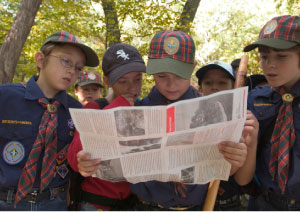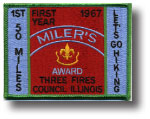Let's Hit the Trail
By Suzanne Wilson
Photographs by Robb Hill
An Illinois pack's monthly hiking program helps younger boys become more confident and comfortable outdoors, making for an easier transition to Boy Scouting.
On a sunny October morning, members of Pack 110, Naperville, Ill.—Tiger Cubs, Wolf and Bear Cub Scouts, Webelos Scouts, families, and leaders—head out on a wooded trail along the Illinois River.
It is a perfect day for a hike that will take them up to the tops of the sandstone bluffs and down into the canyons of Starved Rock State Park.
‘It’s fun’
Pack 110, chartered to Judd Kendall VFW Post 3873, Naperville, goes hiking almost every month.
 Spectacular waterfalls and sandstone rock formations make LaSalle Canyon a favorite stop for Pack 110 during hikes at Starved Rock State Park. |
Mel Sears was Cubmaster in 1991 when he had the idea for a hiking program. “The inspiration was, mainly, I like to hike,” he admits, “plus I wanted to get the boys outdoors more.”
The pack began with four to six hikes per year, but eventually they hit the trail each month. From the start, the Cub Scouts had an extra incentive, a hiking stick for any boy who reached 50 miles. The program “really zoomed” after the first Cub Scout received his hiking stick, Sears says.
The incentive program expanded, and now hikers receive awards for every 10 miles. During their years with the pack, most boys hike 100 miles or more, and many have logged more than 200.
“The Starved Rock hike is the hardest and the most miles [seven] we ever do,” says veteran hiker Andy See, 10, who has participated in the pack’s “hiking club” program since he was 6. “It’s fun,” he adds, “and when you get a lot of miles, you get cool stuff like patches and a hiking stick.”
Besides providing enjoyment and rewards, the program helps boys become confident and comfortable outdoors and encourages healthy habits and lifestyles.
And it makes the transition to Boy Scouting activities easier. For example, when Andy’s brother, Jeremy, 13, became a Boy Scout, he had already hiked a total of 211 miles as a member of Pack 110.
“I think it’s essential to prepare Cub Scouts for Boy Scouts,” says current Pack 110 Cubmaster Steven Bernardi.
 “If you’re a sixth grader and you haven’t been out in the woods a lot, it’s a tougher transition,” adds assistant Cubmaster Greg Pronger, coordinator of the hiking program and a former Cubmaster. Thanks to the program, Pack 110 Cub Scouts are “comfortable going hiking, comfortable with being out in the forest in the snow or the rain,” he says.
“If you’re a sixth grader and you haven’t been out in the woods a lot, it’s a tougher transition,” adds assistant Cubmaster Greg Pronger, coordinator of the hiking program and a former Cubmaster. Thanks to the program, Pack 110 Cub Scouts are “comfortable going hiking, comfortable with being out in the forest in the snow or the rain,” he says.
When leaders in Indian Prairie District of the Three Fires Council had concerns about Webelos Scouts being ready for Boy Scouting activities, Pronger presented his pack’s hiking program at the April 2006 Cub Scouting roundtable.
Someone asked, “What do you do with the little guys?”
He answered, “Just be certain they’ve got a decent pair of shoes on and something to drink, and they’ll go as far as the older guys do.”
Pronger says at least three other packs in the district planned to adopt the program, and several Pack 110 families who moved away have formed hiking clubs in their new packs.
A pack of hikers
For this October hike, families meet at a designated time and place in Naperville and travel 71 miles in numerous leader and parent vehicles to Starved Rock State Park near Utica, Ill.
 The Webelos Scout hike leaders review their route during a rest stop along the trail. |
As they gather outside the visitor center, hiking coordinator Craig See announces that four Webelos Scouts, using a trail map and accompanied by an adult, will lead the hike. See will be the “tail” or “sweeper.”
“Stay in the middle,” he tells the group. “Nobody goes behind me.”
One of the four Webelos Scouts is Jason Piske, 10, who has led hikes before. He says that his job includes “knowing where everyone is and making sure people don’t get in front of you, because they could either get lost or hurt.”
Even some Tiger Cubs qualify as experienced hikers. Tiger Cub den leader Jason Lohman and his son Rahadi, 6, have been on two shorter hikes. Rahadi knows what to pack: “A flashlight, water, a lunch, a few more snacks and stuff.”
Wolf Cub Scout Jarod Thelen, 7, knows another essential: “First-aid kit — my dad’s got it,” he says, pointing to Wolf den leader Rob Thelen’s day pack. Jarod has hiked 39 miles since he became a Cub Scout. “I’m going to get a hiking stick this year,” he promises.
 The trail takes them through the forest, along
the riverside, over boardwalks, and up stairs that seem headed for the sky.
The trail takes them through the forest, along
the riverside, over boardwalks, and up stairs that seem headed for the sky.
The group stops at a lookout point for a view of the actual Starved Rock, a 125-foot-high butte.
(According to American Indian legend, in the 1760’s a band of Illiniwek took refuge on the rock. Trapped by their enemies, the Potawatomi and Ottawa, they died of starvation.)
In LaSalle Canyon, kids explore the sandstone landscape, and several sit in an egg-shaped niche in the wall. A waterfall pours over the bluff.
Kevin and Claire North are on their first hike with their Bear Cub Scout son Ryan, 9. “I’m so glad we came,” says Claire. “It’s beautiful, breathtaking.”
Pam Page, mother of Webelos Scout Brandon, 9, goes on all the hikes. “I enjoy it,” she says. “And it’s healthy to get out. We even hike in winter.”
 Starved Rock is a perennial favorite with these hikers. “I like this place because of the waterfalls and the views; they’re beautiful,” says Steven Laskey, 10, a second-year Webelos Scout.
Starved Rock is a perennial favorite with these hikers. “I like this place because of the waterfalls and the views; they’re beautiful,” says Steven Laskey, 10, a second-year Webelos Scout.
Webelos Scout Zachary Storey, 10, and his brother, Jacob, 7, a Wolf Cub Scout, agree their preferred trek is the “fossil hike” at Mazonia-Braidwood Fish and Wildlife Area, because “we get to dig for stuff,” Zachary says.
Webelos Scout Dean Pappas, 11, likes the River-walk hike in downtown Naperville, “because afterward we get ice cream.”
On the long Starved Rock hike, adults watch for kids who might be tired. On the last uphill climb, the leaders ask if everyone is doing O.K.
Ryan North answers for himself and all his buddies: “Sure! We’re Cub Scouts!”
Contributing editor Suzanne Wilson writes from Joplin, Mo.
Inside Pack 110’s Hiking ClubThe hiking program provides the pack an opportunity to enjoy an outdoor activity that is healthful for boys, their families, and leaders. The basics:
- A system of rewards provides boys and adults with continuing recognition for miles completed. - The presentation of a hiking stick at the 50-mile mark is great motivation for new hikers. Each stick, made by the hiking coordinator or other leader, displays the name of the hiker, the pack number, and “50-mile Club” stamped into a leather grip. - Hikers receive awards at pack meetings. A person who is to receive a hiking stick walks to the front of the room under the crossed sticks of previous 50-milers. - Den leaders take dens on additional hikes and turn in miles. These hikes have a service or educational component, for example, pulling up invasive plants at a park’s workday or finding animal tracks in the snow during a forest preserve event. - Webelos Scouts can count miles hiked at an overnight or at a Boy Scout event. - At a boy’s last pack meeting, he receives a certificate showing his miles, which he takes to a Boy Scout troop. The program’s benefits include: - An outdoor experience and physical activity that prepares Cub Scouts for the transition to a Boy Scout troop’s outdoor program. - Hikes can include opportunities for passing Cub Scout requirements and learning lessons. - Webelos Scouts can lead a pack hike, read maps, and choose trails, with the aid of an adult. - The program may attract new Cub Scouts to the pack. - Families have memorable outdoor experiences together. |
How to Choose a HikeCraig See, Pack 110’s hiking coordinator (and Webelos I den leader) plans a schedule of hikes with these criteria in mind: - A hike should be at least two or three miles long; Pack 110 has several at four or five miles. Most of their hike locations are at forest preserves and parks not far from Naperville. - Plan for variety. “Each hike is unique,” See says. For example, Mazonia-Braidwood Fish and Wildlife Area is where the Cub Scouts hunt for fossils. At the Fullersburg Woods Forest Preserve and Education Center, the boys can see the reconstructed remains of a 13,000-year-old woolly mammoth. - Mix variety with old favorites. The schedule varies year to year. The pack repeats favorite hikes annually, revisits some others in alternate years, and adds newfound locations. - The pack is ready to hike in rain (though not during thunderstorms) and in snow, but in winter they stay relatively close to home in case roads become slippery. - Check in advance with the administrators of the place you want to hike, to see if there is an event scheduled that might overcrowd the trails. - The pack always files a tour permit with Three Fires Council. - Dress properly. In cold weather, before driving to the hike location, check if everyone has the necessary winter clothing. Pack 110 waits for anyone who must go home for a hat, mittens, etc. - Warm or hot weather, it is especially important to carry an adequate supply of water. - Always use the buddy system. —S.W. |
October 2007 Table of Contents
Copyright © 2007 by the Boy Scouts of America. All rights thereunder reserved; anything appearing in Scouting magazine or on its Web site may not be reprinted either wholly or in part without written permission. Because of freedom given authors, opinions may not reflect official concurrence.
 - A hiking coordinator schedules monthly hikes at a variety of locations and keeps track of each person’s miles. (Pack 110 usually skips one summer month when many families are on vacation.)
- A hiking coordinator schedules monthly hikes at a variety of locations and keeps track of each person’s miles. (Pack 110 usually skips one summer month when many families are on vacation.)